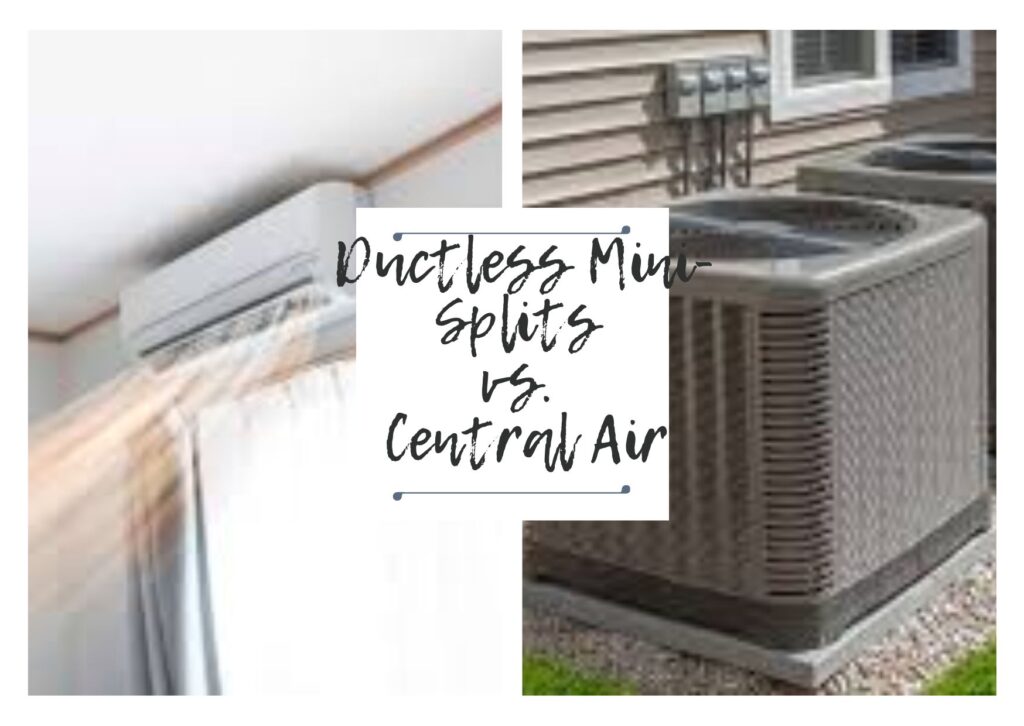
When it comes to ensuring your home is comfortable and efficient, the choice of an air conditioning system is crucial. In this article, we’ll explore two popular options: ductless mini-splits and central air conditioning systems. Both have their unique features and benefits and understanding these can help you make an informed decision. We’ll delve into what each system offers, their pros and cons, and how they compare in various aspects such as energy efficiency, cost, and suitability for different home types.
What is Ductless Mini-Split Systems?
Ductless mini-split systems consist of two main components: an outdoor compressor/condenser and one or more indoor air-handling units. These units are connected by a conduit housing the power cable, refrigerant tubing, and a condensate drain. Mini-splits provide direct heating and cooling to specific zones in the home without the need for ductwork.
Key Features
- Zonal Control: Each unit can be controlled independently, allowing for personalized temperature settings in different rooms.
- Flexibility in Installation: Due to their compact size and lack of ductwork, mini-splits can be installed in various locations.
Reasons to Choose Ductless Mini-Split Systems
- Customized Comfort: Individual control over each zone for personalized comfort.
- Energy Savings: Reduced energy loss, leading to lower utility bills.
- Ease of Installation: No need for extensive ductwork, making them ideal for older homes or extensions.
- Quiet Operation: Generally quieter than traditional central air systems.
Benefits of Ductless Mini-Split Systems
- Versatility: Can be installed in various types of properties, including apartments, older homes, and new additions.
- Improved Indoor Air Quality: Less air leakage and better humidity control.
- Minimal Aesthetic Impact: Compact size and modern designs that blend into interior decor.
What is Central Air Conditioning Systems
Central air conditioning systems circulate cooled air through a system of supply and return ducts. Air is cooled at a central location and distributed through ducts in the walls or floors, then returned to the system to be cooled again.
Key Features
- Whole-Home Cooling: Designed to cool the entire home uniformly.
- Invisible Operation: The ductwork is hidden behind walls, maintaining the aesthetic of the home.
Reasons to Choose Central Air Conditioning Systems
- Consistent Climate Control: Even temperature distribution throughout the home.
- Improved Air Quality: Advanced filtration systems reduce allergens and dust.
- Seamless Integration: Ductwork is hidden, maintaining home aesthetics.
- Higher Resale Value: Often preferred by homebuyers for whole-house cooling.
Benefits of Central Air Conditioning Systems
- Long-Term Cost Efficiency: Potentially lower maintenance costs over time.
- Scalability: Can be expanded or upgraded as needed.
- Ease of Use: Simple, centralized control for the entire system.
- Property Value Enhancement: Adds to the overall value and appeal of the home.
Comparative Analysis – What is Best for your Home?
Energy Efficiency
- Mini-splits are generally more energy-efficient due to direct room-to-room air delivery.
- Central air systems can lose energy through ductwork, especially if not well-insulated.
Cost
- Mini-splits have a higher initial cost but can be more cost-effective in the long run due to lower operating costs.
- Central air systems have a lower initial installation cost but may incur higher energy bills.
Space Requirements
- Mini-splits require less space and are ideal for compact areas.
- Central air systems need space for ductwork and are better suited for larger homes.
Aesthetics
- Mini-splits are visible inside the home but offer modern designs.
- Central air systems are hidden, preserving the home’s interior design.
Maintenance and Longevity
- Mini-splits require regular cleaning of filters and checks.
- Central air systems need duct cleaning, filter changes, and general maintenance.
Suitability for Different Home Types
- Mini splits are perfect for smaller homes, additions, or specific rooms.
- Central air is ideal for larger homes needing uniform cooling.
Climate Considerations
- Mini-splits work efficiently in various climates, especially where heating and cooling needs vary by room.
- Central air systems are effective in consistently hot or cold climates.
User Experience and Comfort
- Mini-splits offer individual control, leading to personalized comfort.
- Central air provides a consistent temperature throughout the home.
Environmental Impact
- Mini-splits often use more environmentally friendly refrigerants.
- Central air systems have a larger environmental footprint due to ductwork and potential energy loss.
Conclusion
Choosing between ductless mini-splits and central air conditioning depends on your specific needs, home layout, and personal preferences. Mini-splits offer flexibility and efficiency, ideal for targeted cooling, whereas central air systems provide uniform cooling for the entire home. We recommend consulting with HVAC professionals, like those at Weather Masters Of Georgia, for personalized advice tailored to your home and lifestyle.

